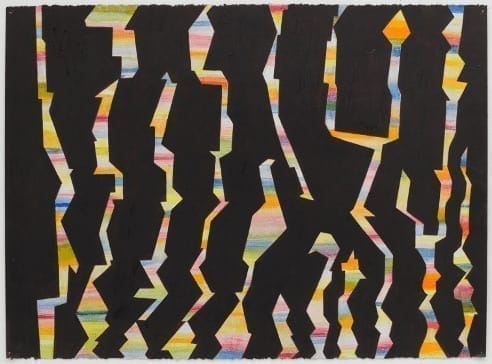Pace Gallery presents All Creatures Great and Small, an online exhibition of abstract and figurative art that evokes the marvelous vitality, as well as vulnerability, of our planet’s flora and fauna. Curated by Pace Gallery Senior Director Samanthe Rubell, President Susan Dunne, and Associate Curatorial Director Michaëla Mohrmann, the exhibition features works by Yto Barrada, Alexander Calder, Harry Callahan, Nigel Cooke, Jean Dubuffet, Emmet Gowin, Peter Hujar, Alex Katz, Richard Misrach, Thomas Nozkowski, Michal Rovner, Raqib Shaw, James Siena, Kiki Smith, Tony Smith, Richard Tuttle, and Fred Wilson. Borrowed from a work on view, the exhibition’s title also cites the opening verse of the 19th-century hymn “All Things Bright and Beautiful,” which describes the genesis of the world in all its diversity. Whimsical and wistful, the works on view share a similar sense of wonder and reverence for living creatures. They offer nature as a source of inspiration while touching upon humankind’s relationship to it—including as a possible conduit to transcendence and spirituality—inviting viewers to ponder creation itself, whether of a biological, artistic, or divine kind.
The exhibition is organized into three thematic sections with titles drawn from the blank verse of Mary Oliver, who rhapsodized about the animal kingdom. The first section, In the Family of Things, features photographs, works on paper, paintings, and small-scale sculptures that capture the quiet dignity of wild creatures, eroding the viewer’s anthropocentrism in favor of kinship. With its perfectly circular eye mirroring the camera’s lens, the rabbit photographed by Peter Hujar returns the viewer’s gaze with force. Just as powerful, a bird depicted in Kiki Smith’s Call appears to momentarily override the bars of its cage with its song. Finding beauty in the circle of life, a wire sculpture by Alexander Calder portrays a dragonfly hovering above a flower it will pollinate—a reciprocity emphasized by the delicate loops forming both organisms. When the human figure appears, as in Nigel Cooke’s Diana and Jean Dubuffet’s Paysage avec 2 personnages, it is primal and even feral—tied to the animal realm.
The second thematic section, A Box Full of Darkness, features works that muddle stark dualities, such as good and evil, life and death, or insider and outsider, by referencing the complexity of nature. The somber hue and austere geometry of Tony Smith’s sculpture is at odds with its title, Seed, which conjures a pattern of organic, verdant growth antithetical to Minimalism. In the paintings of Thomas Nozkowski and Alex Katz, color is on the verge of overtaking darkness, while Michal Rovner finds historical clarity by joining the nighttime world of jackals, symbols for pariahs since biblical times. Playing with the ambiguous material status of glass as a slow-moving liquid commonly mistaken for a solid, Fred Wilson’s Why? renders teardrops in black glass, evoking a chain of associations—water, ink, oil, and tar, for example—that ties the extraction of natural resources to the racist exploitation of human beings.
The exhibition culminates in the third thematic section, Full of Gorgeous Life, which brings together works that convey the plenitude and vitality of nature through an emphasis on variety, the multiplication of minute details, and fields of luminous color. Works by James Siena, Harry Callahan, and Richard Tuttle teem with botanical forms that appear ready to transcend their borders. Expansiveness is also suggested through color in works by Alex Katz and Richard Misrach, conveying an uplifting sense of possibility. Yto Barrada’s vivid Red Palm sculpture exudes buoyancy while addressing the underside of economic development in Morocco, where she grew up.
Collectively, the works presented in All Creatures Great and Small offer a new lens through which to view the natural world, and offer inspiration from nature during a time in which natural wonders are less accessible on a daily basis. The exhibition is on view from April 21 through May 5, 2020.
Pace is a leading contemporary art gallery representing many of the most significant international artists and estates of the twentieth and twenty-first centuries.
Under the leadership of President and CEO Marc Glimcher, Pace is a vital force within the art world and plays a critical role in shaping the history, creation, and engagement with modern and contemporary art. Since its founding by Arne Glimcher in 1960, Pace has developed a distinguished legacy for vibrant and dedicated relationships with renowned artists. As the gallery approaches the start of its seventh decade, Pace’s mission continues to be inspired by a drive to support the world’s most influential and innovative artists and to share their visionary work with people around the world.
Pace advances this mission through its dynamic global program, comprising ambitious exhibitions, artist projects, public installations, institutional collaborations, performances and interdisciplinary projects through Pace Live, and curatorial research and writing. Today, Pace has seven locations worldwide: two galleries in New York—including its newly opened headquarters at 540 West 25th Street, and an adjacent 8,000 sq. ft. exhibition space at 510 West 25th Street—as well as galleries in Palo Alto, London, Geneva, Hong Kong, and Seoul.

